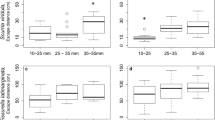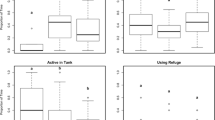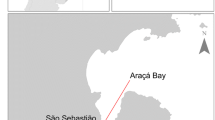Summary
The spined cladoceran Bythotrephes cederstroemi is protected from small fish predators due to the difficulty small fish have in ingesting the spine. Juvenile yellow perch (Perca flavescens) 50–60 mm in length were offered Bythotrephes with alternative prey available in two experiments. First, perch were observed as they gained experience with Bythotrephes and developed aversion to the zooplankter. Perch initially attacked and captured Bythotrephes. However, they struggled to ingest the spined zooplankter, rejected and recaptured it many times, and finally ceased to attack it. Second, perch were offered Bythotrephes with varying portions of the spine removed to clarify the spine's role in inducing such behaviors. Perch showed greater preference to attack nospine and half-spine Bythotrephes, and were less likely to reject and more likely to ingest Bythotrephes with the spine removed. For small or young fish that forage on zooplankton in lakes where Bythotrephes is present, aversion is an efficient response to the conspicuous but unpalatable spined cladoceran. However, aversion allows Bythotrephes, also a predator on zooplankton, to more effectively compete with young fish without an increase in predation risk.
Similar content being viewed by others
References
Barnhisel DR (1990) Juvenile fish response to the cladoceran Bythotrephes cederstroemi. Master thesis, University of Michigan, Ann Arbor, MI USA
Barnhisel DR (1991) The caudal appendage of the cladoceran Bythotrephes cederstroemi as defense against young fish. J Plank Res 13:529–537
Brower LP (1969) Ecological chemistry. Scient Am 220:22–29
Brower LP, Brower JVZ (1962) Investigations into mimicry. Nat Hist 71:8–19
Brower LP, Brower JVZ, Corvino JM (1967) Plant poisons in a terrestrial food chain. Proc Natl Acad Sci 57:893–898
Edmunds M (1974) Defence in Animals; a survey of anti-predator devices. Longman, New York
Evans MS (1988) Bythotrephes cederstroemi: its new appearance in Lake Michigan. J Great Lakes Res 14:234–240
Garcia J, Hankins WG, Rusiniak KW (1974) Behavioral regulation of the milieu interne in man and rat. Science 185:824–831
Farr EJ, Savage GE (1978) First- and second-order conditioning in goldfish and their relation to the telencephalon. Behav Biol 22:50–59
Fisher RA (1958) The genetical theory of natural selection. Dover, New York
Flood NB, Overmier JB (1981) Learning in teleost fish: role of the telencephalon. In: PR Laming (ed) Brain mechanisms of behaviour in lower vertebrates. Cambridge University Press, Cambridge, pp 259–279
Forbes LS (1989) Prey defences and predator handling behaviour: the dangerous prey hypothesis. Oikos 55:155–158
Furnass TI (1979) Laboratory experiments on prey selection by perch fry (Perca fluviatilis). Freshwater Biol 9:33–43
Gilbert JJ (1966) Rotifer ecology and embryological induction. Science 151:1234–1237
Harvell CD (1984) Predator-induced defense in a marine bryozoan. Science 224:1357–1359
Havel JE (1987) Predator-induced defenses: a review. In: Kerfoot WC, Sih A (eds) Predation: direct and indirect effects. University Press of New England, Hanover, pp 263–278
Havel JE, Dodson SI (1984) Chaoborus predation on typical and spined morphs of Daphnia pulex: behavioral observations. Limnol Oceanogr 29:487–494
Holling CS (1966) The functional response of invertebrate predators to prey density. Mem Ent Soc Can 48:3–86
Hoogland R, Morris D, Tinbergen N (1957) The spines of sticklebacks (Gasterosteus and Pygosteus) as means of defence against predators (Perca and Esox). Behav 10:205–236
Jacobs J (1965) Significance of morphology and physiology of Daphnia for its survival in predator-prey experiments. Naturwissenshaften 52:141
Kerfoot WC (1982) A question of taste: crypsis and warning coloration in freshwater zooplankton communities. Ecology 63:538–554
Lehman JT (1988) Algal biomass unaltered by food-web changes in Lake Michigan. Nature 332:537–538
Lorenz KZ (1981) The foundations of ethology. Springer, Berlin Heidelberg New York
Manning A (1972) An introduction to animal behavior (2nd ed). Addison-Wesley, London
Mills EL, Forney JL (1981) Energetics, food consumption, and growth of young yellow perch in Oneida Lake, New York. Trans Am Fish Soc 110:479–488
Mordukhai-Boltovskaia ED (1958) Preliminary notes on the feeding of the carnivorous cladocerans Leptodora kindti and Bythotrephes. Dokl Akad Sci SSSR 122:828–830
Morgan SG (1989) Adaptive significance of spination in estuarine crab zoeae. Ecology 70:464–482
Reist JD (1980) Selective predation upon pelvic phenotypes of brook stickleback, Culaea inconstants, by northern pike, Esox lucius. Can J Zool 58:1245–1252
Ross DM (1971) Protection of hermit crabs (Dardanus spp.) from octopus by commensal sea anemones (Calliactus spp.). Nature 230:401–402
Sokal RR, Rohlf FJ (1981) Biometrics (2nd ed). WH Freeman and Company, San Francisco
Young CM (1986) Defenses and refuges: alternative mechanisms of coexistence between a predatory gastropod and its ascidian prey. Mar Biol 91:513–522
Zaret TM (1980) Predation and freshwater communitics. Yale University Press, New Haven
Author information
Authors and Affiliations
Rights and permissions
About this article
Cite this article
Barnhisel, D.R. Zooplankton spine induces aversion in small fish predators. Oecologia 88, 444–450 (1991). https://doi.org/10.1007/BF00317591
Received:
Accepted:
Issue Date:
DOI: https://doi.org/10.1007/BF00317591




